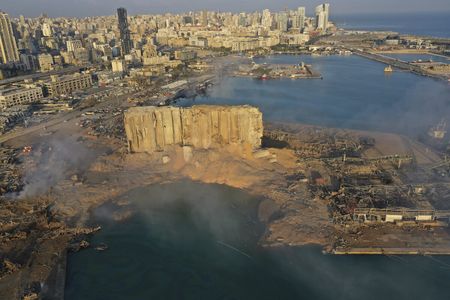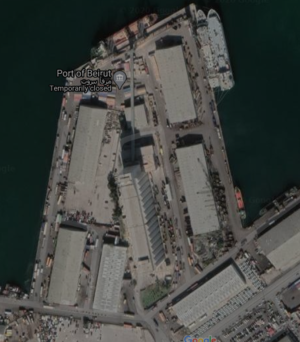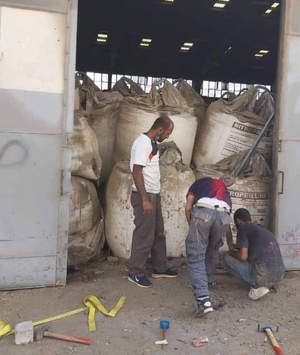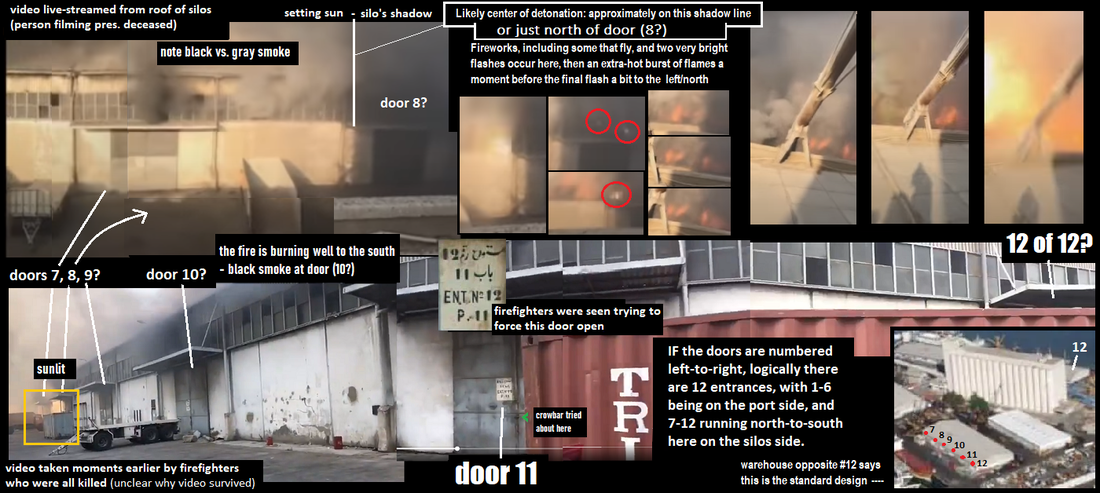Beirut 2020 explosion
Sources
- Massive blast rips through Beirut, killing 50 and injuring thousands - Reuters, August 4, 2020
- 'Balconies were blown off buildings' in Beirut - BBC, August 4, 2020
- Explosion in Lebanon: Security officials announced preliminary findings (PHOTO, VIDEO) - Rusvesna, August 4, 2020
- When carrying out welding work to seal the holes through which intruders could commit theft, a detonation of the cargo stored in the warehouse in the port with 2700 tons of ammonium nitrate occurred
- Repair Work at Beirut Port Hangar May Be Cause of Explosion, Lebanese Defence Council States - Sputnik, August 5, 2020
- Beirut Explosion Video from More Angles, Dozens Still Missing, Beirut Devastated - Syria News, August 5, 2020
- Beirut explosion rocks Lebanon's capital city - CNN, live updates
- The Beirut sea-port explosion - Ghassan Kadi, The Saker blog, August 5, 2020
- Literally thousands of people heard the first explosion, started to take videos of it with their smart phones, unbeknown to them that another huge one was to follow.
Videos
- Patrick Henningsen
- @bigreegs1985
- @ItsSkagg
- Reuters
- Aljazeera
- +18 | Explosion in Beirut | August 4th, 2020 | Lebanon - R&U Videos, August 5, 2020
- Explosion in Beirut: new footage (VIDEO)- Rusvesna, August 5, 2020 (video)
- Two explosions, second much stronger, those who filmed are killed.
- Mushroom cloud over Beirut: Video from 7 different angles - CGTN America, August 4, 2020
- Unseen footage shows moment of Beirut explosion in 4K slow motion - by Agoston Nemeth, via Newsflare
- Inside a Beirut hospital when the blast hit, Sky News, August 11, 2020
- Sky News has obtained exclusive CCTV footage from inside St George Hospital in Beirut, close to where the deadly blast hit one week ago.
- The doctors and nurses describe the moment they felt the first pulse, then the bigger blast.
Events in 2013
- Blame for Beirut explosion begins seven years ago with a faulty Russian cargo ship - Bloomberg News via National Post, August 6, 2020
- A Hidden Tycoon, African Explosives, and a Loan from a Notorious Bank: Questionable Connections Surround Beirut Explosion Shipment - OCCRP and Partners, August 21, 2020
Shipment to Mozambique
- Mozambique confirms that it was supposed to be final destination of cargo that exploded in Beirut - Jorge Joaquim, Pan African Visions, August 11, 2020
- British lawmakers seek investigation into UK-registered firm possibly linked to Beirut blast - Middle East Monitor, January 24, 2021
Allegations
- ‘A bomb of some kind’? Trump says US military officials think deadly Beirut blast was an ATTACK - RT, August 4, 2020
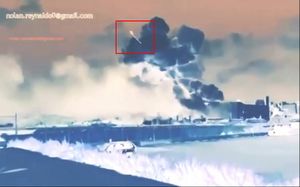
- BREAKING: Israel Bombed Beirut - Richard Silverstein, August 4, 2020
- Ex-CIA Analyst Confirms Beirut Blast Initiated by “Military Munitions,” Lebanese President to Examine Role of “External Actors” - Richard Silverstein, August 6, 2020
- Israel destroys East Beirut with a new weapon - Thierry Meyssan, Voltaire August 6, 2020
- Correction and clarification Voltaire, August 7, 2020
- ‘External interference through rocket, bomb or other act’ possible cause of Beirut blast – Lebanon’s president - RT, August 7, 2020
- Senior Israeli Opposition Leader: Hezbollah Arms Cache Caused Beirut Explosion - Richard Silverstein, August 8, 2020
- Lebanon ex-interior minister: Israel blew up port - Asia Times, August 13, 2020
Welding Claims
- https://news.cgtn.com/news/2020-08-05/Fire-from-welding-work-set-off-blast-in-Beirut-report-SHGQIaPZbq/index.html
- https://www.timesofisrael.com/mystery-swirls-around-what-caused-ammonium-nitrate-to-explode-in-beirut/
- https://sputniknews.com/middleeast/202008051080068619-repair-work-at-beirut-ports-hangar-may-be-cause-of-explosion-lebanese-defence-council-states/
- https://apdnews.com/news/996844.html (pending primary source)
- "A meeting of the Lebanese Supreme Defence Council said that a massive blast in the port of Beirut on Tuesday evening might have been the result of maintenance work at the site, as a door to the port hangar, where explosive materials were being stored, did not close properly, LBCI reported. ... During the meeting, representatives of the Lebanese security service said that an explosion took place as a door was being welded, the channel reported. It was discovered some time ago that the hangar’s door was not properly locked, and there was a gap by the wall, which made it easy to both enter and leave the hangar, the emergency meeting of the defence council said."
- A Reuters report of August 10 gives more detail:
- "In January 2020, a judge launched an official investigation after it was discovered that Hangar 12 was unguarded, had 'a hole in its southern wall and one of its doors dislodged, meaning the hazardous material was at risk of being stolen."
- "In his final report following the investigation, Prosecutor General Oweidat "gave orders immediately" to ensure hangar doors and holes were repaired and security provided, a second high-ranking security official who also requested anonymity said."
- "On June 4, based on those orders, state security instructed port authorities to provide guards at Hangar 12, appoint a director for the warehouse and secure all the doors and repair the hole in the southern wall, according to the state security report and security officials. The port authorities did not immediately respond to requests for comment."
- "The maintenance started and (port authorities) sent a team of Syrian workers (but) there was no one supervising them when they entered to fix the holes," the security official said. During the work, sparks from welding took hold and fire started to spread, the official said. ... The official blamed port authorities for not supervising the repair crew and for storing fireworks alongside a vast deposit of high explosives. Reuters could not determine what happened to the workers repairing the hangar."
- Lebanon 24 (Arabic)
- "The sources said that among the detainees "the three Syrian workers who took over the process of welding (the warehouse door), so that they reported during their interrogation that they were assigned to this task and were not aware of at all the materials stored behind the door, they completed their mission and left the port about an hour before The explosion to show later that one of the sparks of the welding operation had been blown into the (warehouse) containing explosives, causing a fire that quickly led to more than one small explosion, as shown in the video footage"
- The blast is said to happen around 6:08 pm local time, so the fateful sparks are said to fly around 5 pm. There should have been no outward sign of a fire, or the Syrian workers should have been the first to report it. Instead, "About five minutes before 6pm (15:00 GMT) on Tuesday, Beirut's fire brigade received a call from the police, who told them that witnesses had spotted smoke billowing out of the city's port." (Al Jazeera)
It's not certain the three detained workers are the same 3 seen in the famous photo, supplied perhaps first to BBC's Riam Dalati (inset). If so, why is their cameraman not also arrested? It's only possible that of all those present, they could look at and photograph this dangerous cargo without realizing what they were set to weld right next to. The product name might not be translated or recognized as a danger, but the universal signs for flammable and/or explosive seem to be plainly visible.
Furthermore, if these men were sent to weld, we don't see any tools for that, only ones that seem related to forcing entry to doors that are locked or, as said, not opening properly. The same kind of tools are seen used by firefighters trying to gain entry to warehouse 12's door number 11, apparently without success (see below). None of the six visible doors appears to have ever been opened, almost as if the doors had been welded shut from the inside. One door "did not close properly," and once that's fixed, none of them can be opened?
Most of the sealed doors seen in a photo and a video from the firefighters who died are different from the one in this photo, bearing white signs with the door number given, some warning signs, and no visible graffiti, while this one has just a blank white square instead of a sign. However door 7 isn't as clear in having a sign in that white square, and being less clear on that graffiti, just might be the door shown. Furthermore, these images are from the inner or west face of the building, and the door in the photo might be on the east or port side (also the more logical side to keep such off-loaded cargo that would hopefully be re-loaded and shipped away in time).
A video shows the earliest view of the fire is at the far north end of building 12 - so not likely connected to any hole way at its south end. An informed report in fact claims it started in a neighboring warehouse (Reuters: ""The source said a fire had started at port warehouse 9 on Tuesday and spread to warehouse 12, where the ammonium nitrate was stored." This should refer to the next building north, but on maps that's #11, with warehouse 9 not adjacent at all but on the other side of the grain silos (HRI). Just how the fire could spread south to warehouse 12 is not clear. From warehouse 12's north end, the fire visibly spreads to the south so the last videos show the fire centered north of the building's middle, around the second of six doors. It's here many flashing fireworks go off before and after a mid-sized explosion, and in the seconds before the final detonation, seemingly centered in the same basic area.
It's not clear what volume this cargo filled, be it the entire north half of the warehouse or just the middle, full width or just the eastern half or what. But perhaps the cargo extended far enough north of the apparent blast center that the door needing welded opened right onto some of the AN fairly near the north end. With enough fuel available, an fire they started there could burn in both directions, spark the fire seen to the north, and to the south burn mostly around the AN until some intermingled fireworks were ignited an hour later, finally setting it all off. The reports of the fire starting in another warehouse would have to be incorrect, but that's entirely possible.
Otherwise, the door shown may be nowhere near the fire's true origin, and the welding accident explanation it's linked to might be a false lead.
Another account: "A former port worker, Yusuf Shehadi, told the Guardian he had been instructed by the Lebanese military to house the chemicals in warehouse 12" and also says he saw the placement of seized fireworks there back in 2009-10 (years before to the AN shipment), and declared "that outrage rests with the government.” Shehadi may have had prior gripes, having emigrated to Canada since then, but he maintained close contact to the day of the blast. He also said "he had spoken to former colleagues at the port who said workers were attempting to fix a gate outside warehouse 12 with an electrical tool ahead of the blast." It should be noted gate and door are easily confused by the common Arabic word bab, so this may not be a conflict. But "electric toll" - while it could include some kind of electric welding torch - suggests the electricity is the issue, probably shorting out to spark the fire. So it's not clear if the story he gives matches the others we've heard, but it has the same basic time: “This was at 5pm, and after 30 minutes they saw smoke. Firefighters came, and so did state security. Everyone died.”" (The Guardian)
Another account yet: "On Wednesday, the Director General of Beirut Port Hassan Kraytem told local television channel OTV ... Maintenance was conducted on the warehouse door just hours before the blast on Tuesday, he added. "We were asked to fix a door of the warehouse by State Security and we did that at noon, but what occurred in the afternoon I have no idea," he said." (CNN)
- A Hidden Tycoon, African Explosives, and a Loan from a Notorious Bank: Questionable Connections Surround Beirut Explosion Shipment OCCRP detailed investigation has the best look into numerous official documents, adding this:
- "In a July 20, 2020, report to the president and prime minister — just two weeks prior to the explosion — Lebanese security services warned that there were serious security flaws at the facility that left the ammonium nitrate open to theft."
"One door of the unguarded warehouse was missing, while there was also a hole in the southern wall, the report said."
- “In case of theft, the thief could turn these goods into explosives,” the report warned.
Aftermath
- Macron delivers stern message to Lebanon’s leaders on visit to stricken Beirut - Politico, August 6, 2020
- French President Emmanuel Macron delivered a stern warning to Lebanese leaders after landing in Beirut Thursday, saying that other than emergency humanitarian aid, there would be no international aid without reforms.
- First blood of the "Lebanese Maidan" - a policeman is killed (+ PHOTO)) - Rusvesna, August 8, 2020
- "Attempted coup in Lebanon" (photos) - Cassad, August 8, 2020
- Lebanon: The Beirut Blast, Destabilisation, Chaos, an attempt at Regime change - Feroze Mithiborwala, Countercurrents, August 9, 2020
Arrests and Questioning
It's not clear how is under suspicion of wrongdoing and who's just being questioned for clues, but several people involved in managing the port and shipping the ammonium nitrate have been questioned or even put under house arrest.
- https://twitter.com/Dalatrm/status/1291421032537108487 #Lebanon Central Bank - Money Laundering and Terrorism Financing Section - issues decree freezing direct and indirect banking assets of Head of Port Authority, Head of Customs, Frmr Head of Customs, Head of Shipping Manifests Bureau and 3 others. Document dated 06/08/2020.
"The Russian businessman whose explosives blew up Beirut’s port has been interviewed by police at his home in Cyprus - but is likely to avoid any charges."
"Igor Grechushkin was asked a ‘list of questions’ by Cypriot investigators in Limassol this afternoon on behalf of the Lebanese authorities, MailOnline can reveal. ... Grechushkin was not suspected of any wrongdoing," but the ship's captain Boris Prokoshev "said Igor Grechushkin, the owner of the vessel and the ammonium on board, had 'washed his hands' of the vessel, leaving the crew and cargo stranded for months."
"Director General of Lebanese Customs Badri Daher said the country's judiciary was told six times about the hazardous chemicals stored in a warehouse in the Lebanese capital. ... 'We requested that it be re-exported but that did not happen. We leave it to the experts and those concerned to determine why,' Daher said."
"Lebanon has since placed every official responsible for the security of Beirut's port for the last six years under house arrest."
"The public attorney in Lebanon, Ghassan El-Khoury, ordered the arrest of the Director General of Customs, Badri Daher, against the backdrop of the Beirut Port explosion, which killed dozens and injured thousands."
"According to the National News Agency, after an investigation that lasted more than five hours concluded, El-Khoury gave the signal to arrest Badri Daher and keep him under investigation, and to pursue investigations into the circumstances of the Beirut Port explosion." "The agency also reported that the former Director General of Customs, Shafiq Marei, and the director of Beirut Port, Hassan Quraitem, had been arrested and subjected to investigation, based on the reference of the competent judiciary, in the file of the Beirut Port explosion."
"While the number of people arrested exceeded 20 pending investigation, a judicial source revealed to Middle East "The list of arrests is likely to rise, and it will reach large heads that are in the circle of suspicion," he said. ... The sources said that among the detainees "the three Syrian workers who took over the process of welding (the warehouse door), so that they reported during their interrogation that they were assigned to this task and were not aware of at all the materials stored behind the door, they completed their mission and left the port about an hour before The explosion to show later that one of the sparks of the welding operation had been blown into the (warehouse) containing explosives, causing a fire that quickly led to more than one small explosion, as shown in the video footage of the first moments documenting the outbreak. "The level of negligence was so great in this file that the maintenance contractor was unaware of the assets inside the ward that was charged with maintaining his door, while the port administration should have informed him of the presence of highly flammable and explosive materials in the place in order to alert his workers to the need for caution," he said."
Mohamed Al Neser @M_Alneser, "Democracy defender & human-rights activist. Witness of Assad crimes, Rebels violation & Radicals rising in Syria. | Sr. Coordinator of @CEE_Program (DSC)" decries the workers' arrest:
- https://twitter.com/M_Alneser/status/1292157440943849474 The Leb. authorities arrested the 3 workers & they are #Syria|ns. The initial investigations are fingering on "the workers to be behind the fire what caused the #BeirutBlast". The port officials didn't told the firefighters what kind of storage they face to tell the poor workers!
- https://twitter.com/M_Alneser/status/1292157443510882305 My call to the NGOs and Syrian working groups in #Lebanon to defend them immediately and make the Lebanese authorities to release them.
Marwa Osman: "Why would Hezbollah store such chemicals for 6 years in an area controlled by their political foes? I mean it is beyond clear. One can easily track the owners of this shipment that docked in Beirut and find the origin of these chemicals and where they were headed and then tie the pieces together to understand that the same old corrupt elite controlling this port since 1991 were behind this disaster. ... Like everything in Lebanon, jobs in the port were distributed on sectarian bases. Each warlord has his own set of names that gets pushed to be hired in any government position. The director of the port, the managers, all 4 former ministers of public works and transport since 2013 and the judges who were deliberately hiding the case to stop any prosecution, all had an idea of what was stored in port 12. None of them is even affiliated to Hezbollah. On the contrary they are all anti-Hezbollah." "Yesterday the current and former directors of the port were arrested for further investigations, I reckon we will have more information after two weeks concerning these questions."
"Riots have erupted again in the wake of the explosions. ... Saboteurs broke into the Lebanese Foreign Affairs Ministry and reportedly destroyed files and archives. Some commentators suggested that this may be a deliberate interference and obstruction of any investigation into those responsible for the Port explosion."
Arrests
- Head of Beirut Port Koraytem arrested in blast probe - The Daily Star Lebanon, August 18, 2020
- Lebanon: Beirut customs chief arrested in blast probe - Middle East Monitor, August 18, 2020
Ammonium nitrate
Chemical reaction
- 2NH4NO3 → 2N2 + O2 + 4H2O + 236 kJ (1.47 kJ/g; while TNT is 4.2 kJ/g)
- 2750 tons NH4NO3 is roughly 965 tons TNT (and only part of it was involved in the second bang).
- The Tragic Physics of the Deadly Explosion in Beirut - Rachel Lance, Wired, August 8, 2020
- Quantian (Twitter) - CHEMISTRY FACT: Explosives have characteristic "detonation velocities" at which shockwaves expand. Smartphone video records at 30 FPS, so the adjacent frames here suggest the front expands at ~100 m/(1/30 sec), or 3,000 m/sec. Consistent with ammonium nitrate, not black powder.
- Smoke color?
- Explosives expert shares his thoughts on video from the scene - CNN, August 5, 2020
- May said when he was in Baghdad, the telltale sign of an ammonium nitrate explosive was a yellow smoke cloud. The pink or red cloud that was seen, he said, was "not consistent with ammonium nitrate (FWIW ; opinions may differ - the red-shifted low angle of sunlight may be the only difference)
Nitric oxide is a colorless, flammable gas with a slight odor. Nitrogen dioxide is a deep red-orange gas that is poisonous but not flammable. It, along with aerosols, is responsible for the reddish-brown color of smog. At high concentrations it is highly toxic, and can cause serious lung damage. Nitrogen dioxide is a strong oxidizing agent, and is thus very reactive with other compounds.
Hydrazine?
See claim at:
- seemingly informed analysis: https://twitter.com/majoramitbansal/status/1291712241394315264
N2H4 (liquid) + O2 = N2 + 2H2O (gas) + 535 kJ; about 17 kJ/g of N2H4, with oxygen borrowed from air, or about 8.5 kJ/g of air-fuel mix.
More "potent" per weight then ammonium nitrate (or TNT). It needs oxygen for the reaction. So it's "fuel", while ammonium nitrate is an oxidizer. They together are more potent and volatile then separately. Either of them may give red nitrogen dioxide as a product. Probably more oxygen around in ammonium nitrate, and more nitrogen dioxide output. To compare how it looks like, one may look at hydrazine rocket launches and such fuel accidents ( possibly this but chemistry details unclear). There is probably no need for anything extra to see what we see. Hydrazine is highly toxic, and no particular quantity is claimed; it may be zero, in a commercial port, why would one keep there something so toxic and not needed there? Hezbollah (probably) denied, FWIW.
Analysis
- Lebanese Kataeb Party’s Secretary-General Nazar Najarian killed in Beirut blast - Siranush Ghazanchyan, Radio Armenia, August 4, 2020
- Beirut Explosion - Moon of Alabama, August 4, 2020
- Beirut Blast Wrap-up - Moon of Alabama, August 5, 2020
- A video taken from the top of the grain silos next to the warehouse shows uncontrolled explosions of small fireworks within a port warehouse near to where the ammonium nitrate was stored. The small crackling fireworks explosions are followed by a very huge one.
- Mideast Geopolitics & Poetics The US, Israel and Beirutshima - "Taxi", Plato's Guns, August 6, 2020
- Two Scenarios On Beirut’s Deadly Blast – OpEd - Kaveh L. Afrasiabi, Eurasia Review, August 6, 2020
- Israel Is in Shock, in a Sickening Show of Hypocrisy - Gideon Levy, Haaretz, August 7, 2020
- Who Profits from the Beirut Tragedy - Pepe Escobar, Asia Times via The Saker, August 8, 2020
- https://twitter.com/CL4Syr/status/1292816509803229185/photo/1 - my effort at setting the blast center: north end, at the second of 6 doors on this side, 3 doors north of the one firefighters were seen trying to pry open. Note flashes tend to be just left of door 8. The Guardian reported, perhaps in a coincidence: "In addition, the hangar housed a quantity of fireworks, Shehadi said, which customs had confiscated in about 2009-10 and which he said he had personally seen delivered on a forklift. “There were 30 to 40 nylon bags of fireworks inside warehouse 12,” he said. “They were on the left-hand side when you entered the door. I used to complain about this." "
- WHY ISRAEL WAS BEHIND THE BEIRUT BLAST - SyrianGirlpartisan, August 31, 2020 (video)
- Guardian Smears Syria's President With Implausible Link To Beirut's Port Blast - Moon of Alabama, January 15, 2021
- EXCLUSIVE: Beirut blast, the investigation files - Radwan Mortada, The Cradle, August 4, 2021
